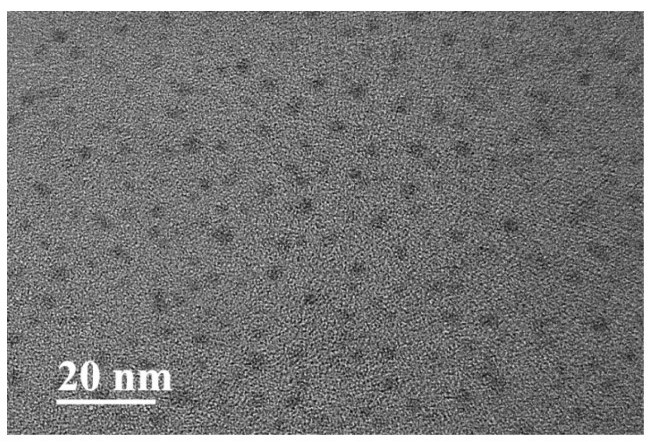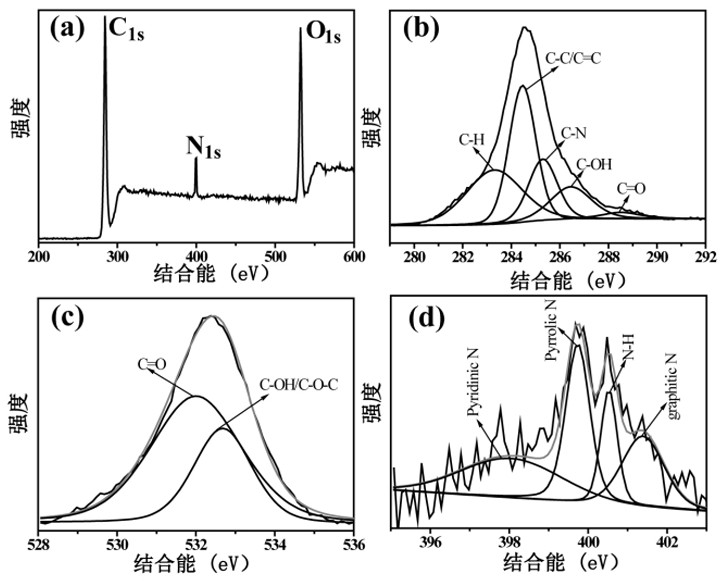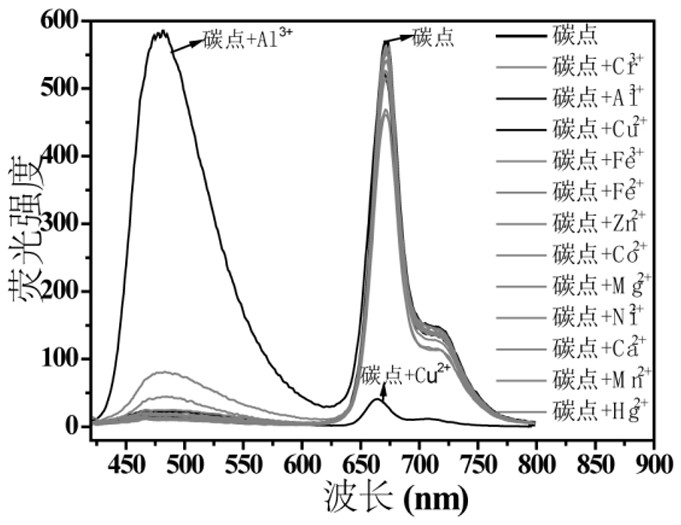A red-blue dual-emission fluorescent carbon dot and its application for simultaneous detection of al 3+ and cu 2+ Ion fluorescence analysis method
A technology of fluorescent carbon dots and ions, applied in fluorescence/phosphorescence, material excitation analysis, chemical instruments and methods, etc., to achieve the effect of simple steps
- Summary
- Abstract
- Description
- Claims
- Application Information
AI Technical Summary
Problems solved by technology
Method used
Image
Examples
preparation example Construction
[0039] The preparation method of the red and blue dual-emission fluorescent carbon dots provided in a typical embodiment of the present invention includes the steps of: grinding dry tea leaves into powder, adding them to the reaction solvent to form a mixture, ultrasonicating at room temperature for 5-15 minutes, and dissolving the above mixture Transfer to a high-pressure reactor and heat the reaction at 140-250°C for 1-24 hours. Within the range of reaction conditions, the heating temperature can be 140-160°C, 160-180°C, 180-200°C, 200-220°C , 220-240°C; heating reaction time can be 1-6 hours, 6-12 hours, 12-18 hours, 18-24 hours. After the reaction, naturally cool to room temperature, centrifuge at 8000-12000 rpm to remove large particles, then filter with a 0.22 μm microporous membrane, and remove the solvent by rotary evaporation to obtain the red and blue dual-emission fluorescent carbon dots.
[0040] According to the above embodiments, the prepared red and blue double ...
Embodiment 1
[0059] Example 1: Preparation of Red and Blue Dual Emission Fluorescent Carbon Dots
[0060] Grind 300 mg of Dahongpao into powder, add it to 10 mL of acetone solvent, ultrasonicate at room temperature for 10 min, transfer the mixture to a 25 mL autoclave, heat and react at 180 °C for 1 hour, and cool to room temperature naturally after the reaction , centrifuge at 10,000 rpm to remove large particles, then filter with a 0.22 μm microporous membrane, and remove the solvent by rotary evaporation to obtain the red and blue dual-emission fluorescent carbon dots. Disperse with absolute ethanol to the desired concentration before use, and store at 4°C for later use. The morphology of red and blue dual emission fluorescent carbon dots is as follows: figure 1 As shown, it presents a quasi-spherical morphology with a size distribution between 2 nm and 4 nm. Taking rhodamine 6G as the reference standard in the range of 600-800 nm, the red and blue dual emission fluorescent carbon dot...
Embodiment 2
[0066] Example 2: Preparation of Red and Blue Dual Emission Fluorescent Carbon Dots
[0067] Grind 500 mg of Tieguanyin into powder, add it to 10 mL of ethanol solvent, ultrasonicate at room temperature for 10 min, transfer the mixture to a 25 mL autoclave, heat and react at 200 °C for 3 hours, and cool to room temperature naturally after the reaction , centrifuge at 10,000 rpm to remove large particles, then filter with a 0.22 μm microporous membrane, and remove the solvent by rotary evaporation to obtain the red and blue dual-emission fluorescent carbon dots. Disperse with absolute ethanol to the desired concentration before use, and store at 4°C for later use.
PUM
 Login to View More
Login to View More Abstract
Description
Claims
Application Information
 Login to View More
Login to View More - R&D
- Intellectual Property
- Life Sciences
- Materials
- Tech Scout
- Unparalleled Data Quality
- Higher Quality Content
- 60% Fewer Hallucinations
Browse by: Latest US Patents, China's latest patents, Technical Efficacy Thesaurus, Application Domain, Technology Topic, Popular Technical Reports.
© 2025 PatSnap. All rights reserved.Legal|Privacy policy|Modern Slavery Act Transparency Statement|Sitemap|About US| Contact US: help@patsnap.com



